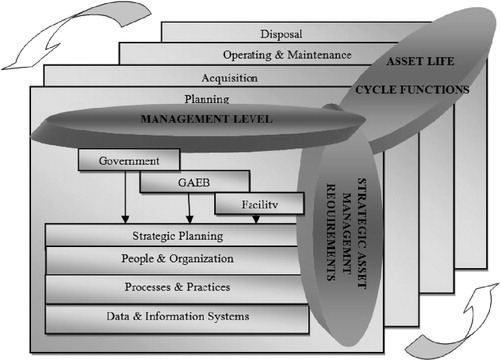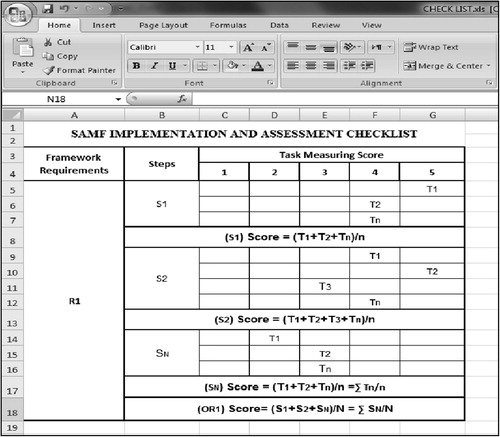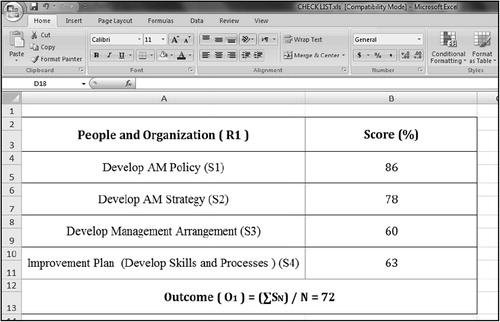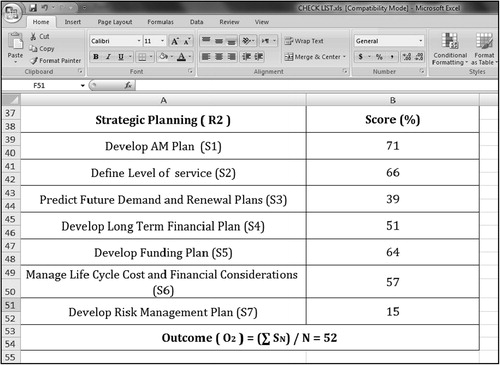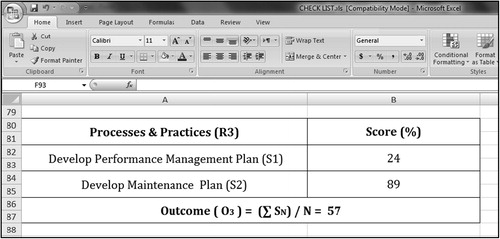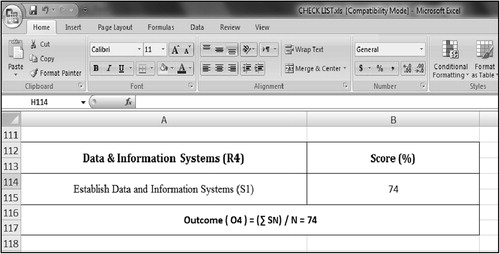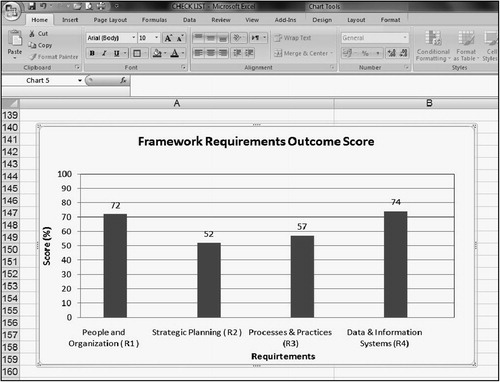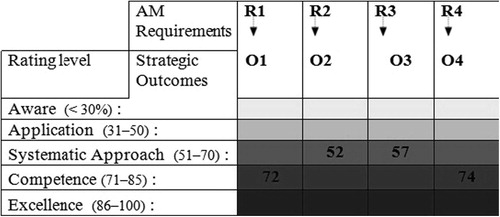 ?Mathematical formulae have been encoded as MathML and are displayed in this HTML version using MathJax in order to improve their display. Uncheck the box to turn MathJax off. This feature requires Javascript. Click on a formula to zoom.
?Mathematical formulae have been encoded as MathML and are displayed in this HTML version using MathJax in order to improve their display. Uncheck the box to turn MathJax off. This feature requires Javascript. Click on a formula to zoom.Abstract
The main objective of this study is to develop a Strategic Asset Management Framework (SAMF) for educational buildings in Egypt. The General Authority for Educational Buildings (GAEB) was chosen as a case study as it represents the biggest governmental organization responsible for planning, operating and maintaining schools in Egypt. This is achieved first through reviewing the literature of strategic asset management. In the next stage, structured interviews were conducted with senior managers of GAEB using a pre designed questionnaire to explore the current practice of asset management (AM). Gap analysis technique was applied against best practices compounded from a vast literature review and showed that the areas related to “people and organization” category are the weakest areas. Based on the findings, a SAMF for GAEB was developed. The study developed a checklist to be applied as a multifunctional tool for framework implementation and self assessment of asset management maturity. The developed checklist tool and its mechanism not only assess the overall AM maturity but also allow assessing the detailed step by step level of implementation of the framework. The framework was developed to improve GAEB AM performance and to reach at least the “Systematic Approach” level as a first stage in the improvement process. The framework has been implemented and the overall performance achieved the target score that lies in the range of Systematic Approach level, more over the areas related to “people and organization” category which represented a main weakness in GAEB have achieved a remarkable improvement.
Introduction
A Strategic Asset Management Framework (SAMF), ties an asset management organization from end to end, and is targeted at improving efficiencies, effectiveness and overall performance while meeting the business objectives. The main objective of this research is introducing a comprehensive SAMF that could be applied to GAEB. The General Authority for Educational Buildings (GAEB) has been chosen to be the case study of the current research as it represents the biggest governmental organization that is responsible for planning, operating and maintaining schools‘ buildings in Egypt. The current research aims at implementing the developed framework on GAEB and assists its performance. The study also developed a checklist to be applied as a multifunctional tool for framework implementation and self assessment of asset management maturity. It helps in providing the main SAM requirements, their steps and tasks to impendent them in order to have a real strategic asset management system and it can also be used as self assessment and allows assessing the detailed step by step level of implementation of the framework.
Strategic asset management
Definition
Office of Facilities Management, Griffith University (2008) [Citation1], defines strategic asset management (SAM) as the planned alignment of physical assets with service demand and achieved by the systematic management of all decision-making processes taken throughout the life of the asset. A holistic view of AM as an integrated business process designed to optimize the use of a utility’s assets while balancing the varying needs of key stakeholders is supported.
Strategic Asset Management Framework (SAMF)
It is a valuable tool which provides departments with a systematic and consistent approach to managing their buildings to meet service delivery requirements. It guides decision-making processes over the life cycle of an asset: planning, investment/procurement, management-in-use and disposal phases, to enhance the management capability of Government departments for the building assets under their control [Citation2].
Strategic approach of asset management
More organizations are adopting a strategic approach in asset management. This new direction can be observed from the guidelines and best practices published by these organizations. Despite the difference in emphasis and perspectives, some common themes can be identified and can be categorized as follows:
| • | Systematic Management – To optimize asset performance, asset management must adopt a systematic and structured process of maintaining, upgrading, and operating physical assets in a cost effective way [Citation3,Citation4]. | ||||
| • | Whole Life Cycle – Life cycle approach is central to asset management by taking account of the total cost of an asset throughout its life [Citation5]. | ||||
| • | Resource Allocation – Asset management can be described as a methodology to efficiently and equitably allocate resources amongst valid and competing goals and objects [Citation6]. | ||||
| • | Service – A better service, not a better asset, is a key indication of successful asset management [Citation5]. | ||||
| • | Strategic Focus – Strategic approach considers the assessment of costs, benefits and level of service provided to ensure that the present needs are met without compromising the ability of future generations to meet their needs [Citation5]. | ||||
SAM requirements
Amadi-Echendu et al. (2010) [Citation7], stated that the key requirements of strategic asset management are:
| (1) | Spatial generality: SAM extends across all types of physical assets, including human resources, in any industry. | ||||
| (2) | Time generality: SAM extends over time to include short term (e.g. utilization) and long term (e.g. lifecycle) aspects of physical assets. | ||||
| (3) | Measurement generality: Measurement data include measurements of the economic value the (financial dimension), social as well as the physical (the capability dimension) attributes of assets. | ||||
| (4) | Statistical generality: Risk and other higher moment estimates of measures are important in SAM as well as the basic, first moment return measure of asset performance. | ||||
| (5) | Organizational generality: SAM takes place at all levels of the organization, from direct contact with the asset to the strategic interactions that take place in the boardroom. | ||||
These five requirements of SAM generality have at least three implications: SAM is multi-disciplinary since it requires input of skills from virtually any discipline source, decisions in SAM extend from operational and tactical aspects of asset management to strategic aspects, the human dimension of SAM requires the use of qualitative modes of analysis as well as the more traditional quantitative modes.
SAMF ties three key links of the organization namely – people, process and technology and on this integration resides the delivery systems of the entire organization. The balance between the people, process and technology is achieved through an adequate understanding of the three links, and ensuring that an appropriate framework exists to retain the bond between these links [Citation8].
Research objectives
The main objective of this research is to develop and implement a Strategic Asset Management Framework (SAMF) to improve the performance of the educational buildings in Egypt. The General Authority for Educational Buildings (GAEB) was chosen as a case study of the current research as it represents the biggest governmental organization responsible for planning, operating and maintaining schools in Egypt.
Research methodology
Research is adopting the “investigation, assessment, resolving and validating” approach and it is aimed to be applied through the following 4 stages:
| (1) | Stage 1: diagnosing the current practice of AM implementation at GAEB
| ||||||||||||||||||||||
| (2) | Stage 2: applying gap analysis
| ||||||||||||||||||||||
| (3) | Stage 3: developing SAMF
| ||||||||||||||||||||||
| (4) | Stage 4: implementing SAMF in GAEB
| ||||||||||||||||||||||
Current practice and gap analysis
The Assessment of current asset management practice at GAEB in stage 1 revealed the following: limited knowledge about strategic asset management, no clear goals, no training, no real risk plan and lack of data, technical and financial resources [Citation9]. The goal of gap analysis in stage 2 is to determine how well/far an organization is performing against the best practices. The gap analysis process has been carried out generally in accordance with the International Infrastructure Management Manual, (2006) [Citation10] as it is the most widely known guideline in the field of asset management. The research is following the outline of the scoring system represented in . According to Abdelhamid et al. (2013) [Citation9], the weighted gap score approach has been applied to identify the areas that most need improvement. From a SAM perspective, the gap analysis resulted in a number of items that have been ranked according to their priority for improvement as shown in . Gap analysis reveals that the GAEB practices of asset knowledge, systems, processes, Information and strategies are generally reaching the level of “Awareness” and/or “Application”. Advancing the application of AM to reach “Systematic Approach” level as a first stage in the improvement process urged the focus on areas for improvement especially “people and organization”.
Table 1 Scoring system.
Table 2 The need for improvement priority.
Proposed framework
To maintain and improve the level of performance of an asset it is essential to integrate strategies, plans and practices in the different levels of management through the asset life cycle. This urges the need for a comprehensive multi dimensional approach. Reviewing the literature and studying different models, strategies and frameworks led to; each of the three dimensions SAMFs introduced by South Australians Framework (1999) [Citation11], and Queensland Government buildings guidelines, Australia, (2010) [Citation2], were found to be the most appropriate approach for achieving the previous requirements. Therefore a modified three dimensions SAMF has been developed to be implemented in GAEB.
Three dimensions framework
The developed Framework is illustrated in and represents the following three dimensions:
| (1) | Management levels | ||||
There are three main levels of AM: Government, Agency (GAEB), and Facilities. Each level has its own management responsibilities and activities. Information flow system should be developed to ensure that all processes are clear to all levels.
| (2) | Life-cycle functions | ||||
Different tasks are to be performed at different stages of the asset’s life, so the life cycle of assets should include these functions: Planning, Acquisition/Procurement, Operation and Maintenance, and Disposal.
| (3) | SAM requirements | ||||
They are the Management’s needs that ensure all organizational requirements that consider the structures, staff, resources and information will best support the AM process. It includes: People and Organization, Strategic Planning, Data and information systems, and Processes and Practices.
The developed SAMF provides departments in GAEB with a systematic and consistent approach to manage their buildings to meet service delivery requirements. It guides decision-making processes over the life cycle of an asset to enhance the management capability of departments for the building assets under their control.
Framework implementation and assessment
The framework implementation process emphasizes on the dimension of “SAM requirements” where the requirements comprise the plans and processes that should be in place in order to apply the SAMF effectively and enhance the areas that need improvement such as: AM knowledge, organization strategy and plan, training, roles and responsibilities. To facilitate the implementation process, the study developed a checklist to be applied as a multifunctional tool for framework implementation and self assessment of AM maturity in GAEB. The chick list includes the four requirements (R), each requirement is divided into a number of steps (S) that should be implemented through a number of tasks (T) to achieve a strategic outcome (O). Implementing the framework is aimed at raising the level of AM practice to reach at least the “Systematic Approach” level.
The developed checklist can also be used as an assessment tool where the corresponding strategic outcomes for each requirement are displayed in the checklist to measure the level of AM maturity against it and a scaled score ranging from 1 to 5 is applied for each task. The scale represents the level of AM maturity as follows: (1) for aware (<30%), (2) for Application (31–50), (3) for Systematic Approach (51–70), (4) for Competence (71–85) and (5) for Excellence (86–100). After developing the check list for framework implementation and self assessment, the framework has been implemented using the developed checklist. The implementation process took place in four months and then the asset management maturity of GAEB was measured using the developed checklist through personal interviews to obtain the score that closely describe the implementation level of the task. The interviews were conducted with top and middle level managers to maximize the quality and the credibility of the results. After the data have been collected, the responses were coded to enable them to be computer processed. Microsoft Office Excel 2007 for Windows was used for the analysis. The mechanism of the assessment process is based on the assumptions that for each step all the tasks have the same weight and for each requirement all steps have the same weight. Also the average of each AM maturity level in the given scale is taken when respondents choose the level of AM maturity. The mechanism is to be applied according to the following steps:
| • | For each task (T), a measuring score that most closely describes GAEB practice is given according to the responses of the interviewers. | ||||
| • | For each step (S), get the average score from the corresponding tasks according to the following equation: | ||||
| • | For each requirement (R), get the average score from the corresponding steps which reflects the amount of the achieved strategic outcome (O) according to the following equation: | ||||
| • | Assign the gained score OR against the different levels of maturity in the overall maturity matrix to indicate the level of SAM practice in GAEB. | ||||
Results and discussion
| (1) | People and organization requirement (R1) is divided into four main steps as follows:
| ||||||||||||||||||||||||||||
The people and organization requirement scores are summarized in . The analysis reveals that developing AM policy step is the most practiced step in GAEB and that the management arrangement step is the lowest. The low governance and management arrangement scores show that asset management is not linked to service delivery properly due to that in GAEB, they do not have AM department but they do some functions of AM and AM team is not identified. The low score of Improvement plan step indicates that they still do not provide enough training and their continuous improvement plan needs more refining. The high AM policy step score reflects how good GAEB outlines government’s asset management objectives, targets and plans.
It is worth noticing that the areas related to “people and organization” category which represent more than 20% of SAM elements were on the top of areas that need improvement and it is crucial as the first stage in the improvement process. The overall assessment of this category showed a remarkable improvement.
| (2) | Strategic planning requirement (R2) is divided into seven main steps as follows:
| ||||||||||||||||||||||||||||||||||||||||||||||
The Strategic Planning requirement steps scores are summarized in . The analysis indicates that developing AM plan step (S1) is the most practiced step in GAEB which shows that level of service and the processes used to manage assets are well defined and that the developed checklist helped in implementing this requirement. The analysis also reveals that GAEB still cannot develop a risk management plan (S7) because they do not realize its importance and they do not have risk management team like most of the places in Egypt that do not take risk into consideration. Also the low score for Predict Future Demand and Renewal Plans (S3) step indicates there is still a lack of studies for needs and improvement conditions. On the other hand there is some improvement in developing funding plan.
| (3) | Processes and Practices requirement (R3) is divided into two main steps as follows:
| ||||||||||||||||
The Processes and Practices requirement steps scores are summarized in . The analysis shows that developing maintenance plan step is greatly improved in GAEB; however the performance management plan is still poorly practiced. This could be attributed to the fact that GAEB is not systematically responsible for operation, they just do it when it is required.
| (4) | Data and Information System requirement (R4) is composed of one main step as follows:
| ||||||||||
The Data and Information System requirement step score is summarized in which shows that GAEB establish data and information system is practiced well as they have their own data base and information system.
The Framework requirements scores are summarized in . After analysis of the framework implementation and self assessment using the check list, the current asset management maturity at GAEB was calculated using the maturity matrix as shown in . The maturity matrix shows that both People and Organization (R1) and Data & Information Systems (R4) lie in the range of competence level while Strategic Planning (R2) and Processes & Practices (R3) lie in the range of Systematic Approach level.
The high score of R4 (Data & Information Systems) implies that the framework assists GAEB to be more aware of the importance of information system, have their own asset register and data base and use special IT system. Also the high score of People and Organization requirement (R1) reveals the GAEB’s effort in developing asset management strategy and policy. The framework implementation shows that they recognize the importance of the improvement plan and management arrangement but need to establish a team for asset management. It is worth noticing that the areas related to “people and organization” category which represent more than 20% of SAM elements and were on the top of areas that need improvement have been improved to reach not just the “Systematic Approach” level but it reached the “ competence” level.
GAEB modestly apply life cycle costing and develop Long Term Financial Plan. They do develop asset management plan, funding plan and define level of services. Strategic planning is a comprehensive long term planning that needs more effort to be accomplished; GAEB can improve this requirement by the detailed and carful implementation of the developed SAMF.
The overall framework score is 64 which lies in the range of Systematic Approach level. The framework was developed aiming that its requirements will be practiced to reach at least the “Systematic Approach” level as a first stage in the improvement process, the results show that it is achieved. The main obstacles that constrain reaching higher levels were found to be limited practice of strategic asset management and lack of technical and financial resources.
Conclusions and recommendations
| (1) | The study developed a SAMF and a checklist to be applied as a multifunctional tool for framework implementation and self assessment of AM maturity in GAEB. | ||||
| (2) | The maturity matrix shows that categories of “People and Organization” and “Data & Information Systems” have exceeded the target level and reached the competence level while “Strategic Planning” and “Processes & Practices” achieved the Systematic Approach level as targeted. | ||||
| (3) | The overall performance of GAEB after the framework implementation lies in the range of Systematic Approach level. | ||||
| (4) | The main feature of the developed framework and assessment tool is it can be used by all management levels and at all stages of implementing an asset management program. | ||||
| (5) | The developed SAMF can be used by any organization of any size however there will only be some modification in the implementation of detailed tasks explained in the checklist according to the organization’s field of work. | ||||
| (6) | The developed simple and easy to apply chick list facilitates the implementation of the model. | ||||
| (7) | It can also be used as self assessment and allows assessing the detailed step by step level of implementation of the framework. | ||||
| (8) | It helps frame the discussion on prioritizing gaps and developing implementation plans, however it is does not provide prepackaged solutions where every local government identifies its needs and the corresponding potentials and available resources. | ||||
| (9) | An extended implementation of the framework is required to identify the possible barriers of the implementation and/or assessment process. | ||||
Notes
Peer review under responsibility of Housing and Building National Research Center.
References
- Griffith University, office of facilities management, strategic asset management plan, 2008, <http://www.gu.edu.au/ofm/publications/pdf/pub_samplan_2005-2008.pdf.
- Queensland GovernmentStrategic Asset Management Framework2010Queensland Department of Public WorksBest Practice Guidelines for the Management of Queensland Government buildings
- Federal Highway Administration FHWAAsset Management Primer1999A Report prepared by the U.S.Department of Transportation
- AUSTROADS“Strategy for improving asset management practices”1997Austroads IncorporatedSydney, Australia
- Local Government Victoria, (LGV)“Asset Management Policy, Strategy and Plan”2004Department of Victorian Communities, Local Government VictoriaMelbourne
- AASHTO“Transportation Asset Management Guide”, prepared for the National Cooperative Highway Research Program (NCHRP)2002AASHTO Publication RP-TAMG-1Washington, DC
- J.E.Amadi-EchenduR.WillettK.BrownJ.MathewWhat Is Engineering Asset Management? – Definitions, Concepts and Scope of Engineering Asset Management2010SpringerLondon
- Ankur Maheshwari, “Development of a strategic asset management framework”. In: Proceedings of the 1st World Congress on Engineering Asset Management (WCEAM), Western Australia, 2006; 103:1–10.
- Manal S. Abdelhamid, Ireny Beshara, Mashhour Ghoneim, “Asset management for educational building in Egypt”, international conference on civil, environmental and infrastructure engineering (ICCEIE), Copenhagen, Denmark, 2013. World Academy of Science, Engineering and Technology, International Science Index: Online Special Journal, Issues; 0078–2013; 335: 1972–1981.
- IPWEAInternational Infrastructure Management Manual2006Institute of Public Works Engineering of Australia
- Government of South AustraliaStrategic Asset Management Framework2nd ed.1999Department of Treasury and FinanceSouth Australia

